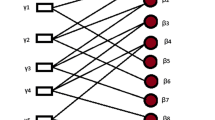Abstract
Energy efficiency and error free transmission have become prime concerns in wireless communication in recent years. Such networks are much more affected by errors due to dynamic channel conditions than normal wired networks. Error control coding is commonly used in the entire range of information com-munication to reduce the harmful effects of the channel. In order to overcome the communication errors in an energy efficient way, an error control mechanism with less complexity is required. Energy efficient error control techniques to prolong network lifetime in resource limited network and wireless communication remains a challenge. This paper forms a survey of recent developments on the various energy efficient error control coding techniques used in wireless communication and resource limited networks/hardware.
Similar content being viewed by others
References
M. E. Pellenz, R. D. Souza, and M. S. Pereira Fonseca, Springer Telecommun. Syst. 44, 61 (2010).
G. Balakrishnan, M. Yang, Y. Jiang, and Y. Kim, in Proc. 4th. Int. Conf. Inf. Technol., Las Vagas NV, Apr. 2–4, 2007 (IEEE, New York, 2007), p. 876.
J. M. Paul Havinga, CTIT Tech. Rep. 19 (1998).
A. Chockalingam and M. Zorzi, in Proc. Veh. Technol. Conf., Ottawa, May 18–21, 1998 (IEEE, New York, 1998), p. 820.
Hong Chen, G. R. Maunder, and L. Hanzo, IEEE Commun. Surv. Tutorials. 15, 1553 (2013).
L. Hanzo, T. H. Liew, B. L. Yeap, R. Tee, and S. X. Ng, Turbo Coding, Turbo Equalisation and Space-Time Coding for Transmission over Fading Channels, 2nd Edition, (Wiley, New York, 2011).
R. Hamming, Bell Syst. Tech. J. 29, 147 (1950).
J. D. Costello and J. Hagenauer, IEEE Trans. Inf. Theory 44, 6 (1998).
B. Honary and G. Markarian, Trellis Decoding of Block Codes (Kluwer Academic, Dordrecht, The Netherlands, 1997).
Mohammad Rakibul Islam, Proc. World. Acad. Sci. Eng. Technol., No. 4, 01 (2010).
A. Angelin, B. Revathi, T. Gayathri, and D. Balakumaran, Int. J. Adv. Res. Electr. Electron. Instrum. Eng., 3, 2278 (2014).
C. M. Vuran and F. I. Akyildiz, IEEE/ACM Trans. Networking 17, 1063 (2009).
L. S. Howard, C. Schlegel, and K. Iniewski, EURASIP J. Wireless Communications Networking 2, 1 (2006).
M. P. Singha and P. Kumar, Elsevier Proc. Techol. 3, 737 (2012).
Zhen Tian, Dongfeng Yuan, and Quanquan Liang, in Proc. Wireless Commun. Mobile. Comput. Int. Conf. Crete Ireland, Aug. 6–8, 2008 (IEEE, New York, 2008), p. 401.
V. Nithya, B. Ramachandran, and V. Bhaskar, Springer Wireless Pers. Commun. 77, 675 (2014).
Chia-Hsiang Yang, Ting-Ying Huang, Mao-Ruei Li, and Yeong Luh Ueng, IEEE Trans. Circuits. Syst. 61, 1549 (2014).
Jasvinder Singh and Dirk Pesch, Springer Telecommun Syst. 52, 2573 (2013).
N. J. Rehman, N. Alrajeh, Z. A. Khan, B. Manzoor, and S. Ahmed, Elsevier Proc. Comput. Sci. 21, 449 (2013).
C. R. de Albuquerque, C. D. Cunha, and C. Pimentel, EURASIP J. Adv. Signal Process 28, 1687 (2013).
S. Ezhilarasan and Dr. P. K. Jawahar, Int. J. Electron. Commun. Eng. Adv. Res. 2, 2347 (2014).
X. Zhang, Y. Wu, J. Zhu, and Yu Zheng, IEEE Trans. VLSI Syst. 20, 1063 (2012).
V. Miloslavskaya and P. Trifonov, LCommun. Lett. 18, 1089 (2014).
Devendra Made, R. B. Khule, and Dipak Iwanate, Int. J. Eng. Trends. Technol. 4, 2231 (2013).
Xiali Van, Wenquan Feng, Qi Zhao, and Hongbo Zhao, in Proc. 3rd Int. Conf. Adv. Comput. Theory. Eng., Chengdu, Aug. 20–22, 2010 (IEEE, New York, 2010), p. 443.
X. Huang, Y. Zhang, J. Xu, and Y. Wang, in Proc. 4th. Int. Conf. Nat. Comput., Jinan, Oct. 18–20, 2008 (IEEE, New York, 2008), p. 619.
S. Huang, K. Tian, F. Tian and J. Yuan, in Proc. 5th. Int. Conf. Wireless Mobile Multimedia Networks, Beijing, Nov. 25–28, 2013 (IEEE, New York, 2013), p. 106.
A. Ghaida AL-Suhail, and W. Khalid Louis, and Turki Y. Abdallah, Int. J. Comput. Sci. Issues. 9, 1694 (2012).
Jasvinder Singh and Dirk Pesch, Springer Telecommun. Syst. 55, 253 (2014).
C. E. Shannon, “A mathematical theory of communication,” Bell Syst. Tech. J. 27, 379 (1948).
Hang Liu, Hairuo Ma, Magda El Zarki, and Sanjay Gupta, Springer Mobile Networks Appl. 2, 167 (1997).
Lin Xing and Wei Wang, Elsevier Comput. Commun. 36, 162 (2013).
Z. Abbas, N. Javaid, A. Javaid, et al., World Appl. Sci. J. 22, 97 (2013)
W. Stark, H. Wang, A. Worthen, et al., IEEE Wireless. Commun. 9 (4), 60 (2002).
M. Y. Naderi, R. H. Rabiee, M. Khansari and M. Salehi, Elsevier Ad Hoc Networks J. 10, 1028 (2012).
R. Chaudhary and V. Gupta, Int. J. Comput. Appl. Eng. Sci. 1, 2231 (2011).
V. Raghunathan, IEEE Signal. Process. Mag. 19 (2), 40–50 (2002).
C. Schuler, Int. J. Wireless Inf. Networks 5, 1068 (1998).
L. Liang, G. R. Maunder, and M. B. Al-Hashimi, and L. Hanzo, IEEE Trans. VLSI. Syst. 21, 1063 (2013).
P. J. Woodard and L. Hanzo, IEEE Trans. Veh. Technol. 49, 18 (2000).
J. T. Richardson and R. L. Urbanke, IEEE Trans. Inf. Theory. 47, 638 (2001).
A. Shokrollahi, Coding, Cryptography and Combinatorics 23, 85 (2004).
Author information
Authors and Affiliations
Corresponding author
Additional information
The article is published in the original.
Rights and permissions
About this article
Cite this article
Salija, P., Yamuna, B. Optimum energy efficient error control techniques in wireless systems: a survey. J. Commun. Technol. Electron. 60, 1257–1263 (2015). https://doi.org/10.1134/S1064226915110157
Received:
Published:
Issue Date:
DOI: https://doi.org/10.1134/S1064226915110157




